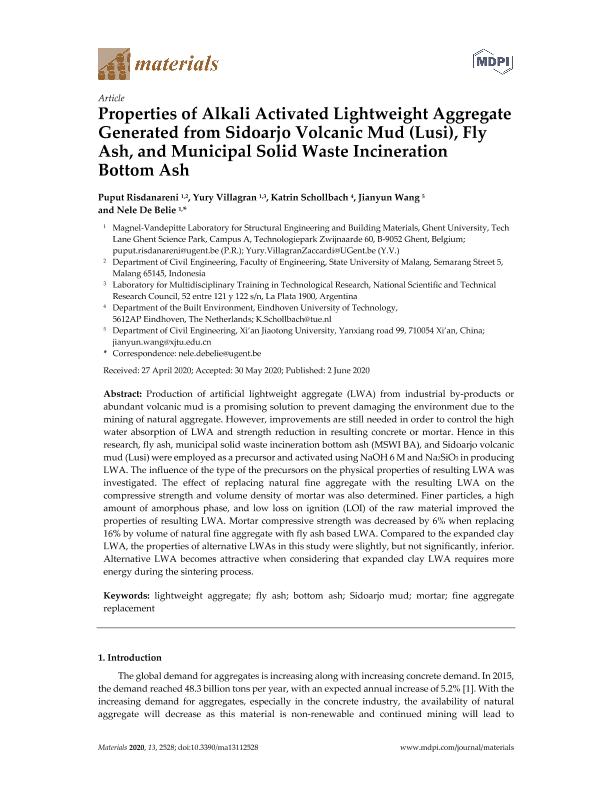Mostrar el registro sencillo del ítem
dc.contributor.author
Risdanareni, Puput
dc.contributor.author
Villagrán Zaccardi, Yury Andrés

dc.contributor.author
Schollbach, Katrin
dc.contributor.author
Wang, Jianyun
dc.contributor.author
de Belie, Nele

dc.date.available
2021-07-20T12:43:40Z
dc.date.issued
2020-06
dc.identifier.citation
Risdanareni, Puput; Villagrán Zaccardi, Yury Andrés; Schollbach, Katrin; Wang, Jianyun; de Belie, Nele; Properties of alkali activated lightweight aggregate generated from Sidoarjo Volcanic Mud (Lusi), fly ash, and municipal solid waste incineration bottom ash; Molecular Diversity Preservation International; Materials; 13; 11; 6-2020; 1-19
dc.identifier.issn
1996-1944
dc.identifier.uri
http://hdl.handle.net/11336/136486
dc.description.abstract
Production of artificial lightweight aggregate (LWA) from industrial by-products or abundant volcanic mud is a promising solution to prevent damaging the environment due to the mining of natural aggregate. However, improvements are still needed in order to control the high water absorption of LWA and strength reduction in resulting concrete or mortar. Hence in this research, fly ash, municipal solid waste incineration bottom ash (MSWI BA), and Sidoarjo volcanic mud (Lusi) were employed as a precursor and activated using NaOH 6 M and Na2SiO3 in producing LWA. The influence of the type of the precursors on the physical properties of resulting LWA was investigated. The effect of replacing natural fine aggregate with the resulting LWA on the compressive strength and volume density of mortar was also determined. Finer particles, a high amount of amorphous phase, and low loss on ignition (LOI) of the raw material improved the properties of resulting LWA. Mortar compressive strength was decreased by 6% when replacing 16% by volume of natural fine aggregate with fly ash based LWA. Compared to the expanded clay LWA, the properties of alternative LWAs in this study were slightly, but not significantly, inferior. Alternative LWA becomes attractive when considering that expanded clay LWA requires more energy during the sintering process.
dc.format
application/pdf
dc.language.iso
eng
dc.publisher
Molecular Diversity Preservation International

dc.rights
info:eu-repo/semantics/openAccess
dc.rights.uri
https://creativecommons.org/licenses/by-nc-sa/2.5/ar/
dc.subject
BOTTOM ASH
dc.subject
FINE AGGREGATE REPLACEMENT
dc.subject
FLY ASH
dc.subject
LIGHTWEIGHT AGGREGATE
dc.subject
MORTAR
dc.subject
SIDOARJO MUD
dc.subject.classification
Ingeniería Civil

dc.subject.classification
Ingeniería Civil

dc.subject.classification
INGENIERÍAS Y TECNOLOGÍAS

dc.title
Properties of alkali activated lightweight aggregate generated from Sidoarjo Volcanic Mud (Lusi), fly ash, and municipal solid waste incineration bottom ash
dc.type
info:eu-repo/semantics/article
dc.type
info:ar-repo/semantics/artículo
dc.type
info:eu-repo/semantics/publishedVersion
dc.date.updated
2021-07-15T12:26:18Z
dc.journal.volume
13
dc.journal.number
11
dc.journal.pagination
1-19
dc.journal.pais
Suiza

dc.journal.ciudad
Basel
dc.description.fil
Fil: Risdanareni, Puput. Universitas Negeri Malang; Indonesia. University of Ghent; Bélgica
dc.description.fil
Fil: Villagrán Zaccardi, Yury Andrés. University of Ghent; Bélgica. Consejo Nacional de Investigaciones Científicas y Técnicas. Centro Científico Tecnológico Conicet - La Plata; Argentina
dc.description.fil
Fil: Schollbach, Katrin. Eindhoven University of Technology; Países Bajos
dc.description.fil
Fil: Wang, Jianyun. Xi'an Jiaotong University; China
dc.description.fil
Fil: de Belie, Nele. University of Ghent; Bélgica
dc.journal.title
Materials
dc.relation.alternativeid
info:eu-repo/semantics/altIdentifier/url/https://www.mdpi.com/1996-1944/13/11/2528
dc.relation.alternativeid
info:eu-repo/semantics/altIdentifier/doi/http://dx.doi.org/10.3390/ma13112528
Archivos asociados
